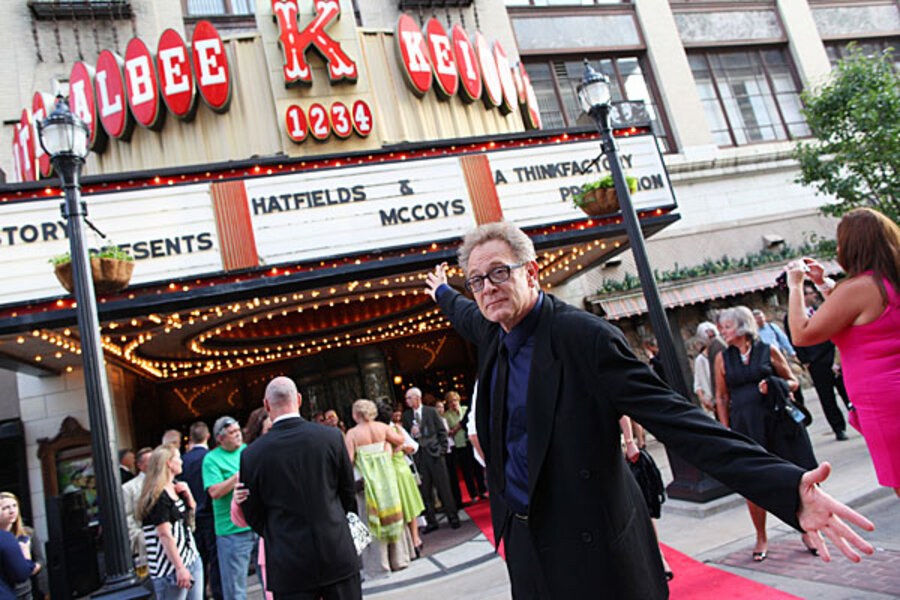'Hatfields and McCoys': Is History Channel miniseries fact or fiction?
Loading...
| Los Angeles
There is something about portraying grimy men shooting one another in the woods that speaks to many actors of a certain, let’s say, experience.
The History Channel’s “Hatfields and McCoys,” a six-hour miniseries about the 19th-century folk legend, airing on the basic cable channel through Wednesday night, is chock full of some of Hollywood’s top frontier-lovin’ hombres. Star Kevin Costner won an Oscar for his Civil-War-era “Dances with Wolves,” and Powers Booth may have set a high-water mark for portraying gritty outlaw life in HBO’s "Deadwood.”
But this is not a feature film or even HBO. This is the History Channel debuting its first scripted series, coming out of the gate with the somewhat lofty goal of illuminating some of history’s lesser-known corners. While most Americans may know the reference to the 19th-century Appalachian blood feud, few know more than the gun-toting, cartoon cowboy characters who shoot at each other and miss.
And so, this largely unfamiliar but profoundly foul-mouthed, violent depiction of frontier justice and family revenge may be just the ticket for a channel trying to shed its somewhat stuffy legacy, says Josh McMullen, chairman of the Government, History, and Criminal Justice Department at Regent University's School of Undergraduate Studies.
“The History Channel’s 'Hatfields and McCoys' is in keeping with the station's recent trajectory towards popular culture rather than rich, historical analysis,” he says via e-mail, adding that much of the programming on the channel – such as “American Pickers" and “Pawn Stars" – is “more akin to reality television than it is to a historical documentary.”
These shows focus on Americana as much as they do on American history, notes Professor McMullen. The History Channel’s "Hatfields and McCoys" continues the theme, as it has been a long-standing American folk legend, he adds.
As with any program trying to separate the threads of a little-documented historical period, he says, the difficulty is separating fact from fiction when discussing the famous feud. One major problem anyone faces in attempting to explore history’s overlooked, disenfranchised, or maligned is that often these are individuals with little desire – or little capacity – to tell their own stories. “These were not regions of the country where people were keeping careful track of their own stories,” says Thomas Flagel, a historian at Columbia State Community College in Franklin, Tenn., and author of “The History Buff’s guide to the Civil War.”
Many participants in this story lived in isolated areas where it would be difficult to trace events accurately, he says. This was not helped by the yellow journalism of the time. If the sketchy events emerging from news accounts as the bodies piled up were not sensational enough, he adds, “newspapers of the day often had no problem with simply making things up.”
Nonetheless, the show's producers were at pains to point out in press materials that while not actually filmed in Appalachia – the incentives are better in Romania, where it was shot – the miniseries “tries to capture accurately details of the family fight that eventually involved the US Supreme Court, made international headlines, and nearly pushed Kentucky and West Virginia to the brink of war.”
Historians and educators were also brought in to vet the story, according to the show's producers, though writers “took such traditional liberties as compressing characters and the timing of events.”
How far is too far often depends on whose views are offended, says Bob Thompson, founder of the Bleier Center for Television and Popular Culture at Syracuse University in New York. He points to the ruckus raised over recent programs such as “Game Change,” about the 2008 election, noting that criticism often had as much to do with politics as history. Beyond that, “drama has no obligation to be historically accurate,” he says with a laugh, pointing to such august precedents as Shakespeare’s history plays.
But, notes McMullen, the miniseries also raises larger questions for the History Channel itself. Does the show do justice to its historical claims, he says, “or is it simply content to entertain its viewers?” he asks. With other cable television shows such as “Game of Thrones” and “True Blood” pushing the envelope in terms of sex and blood, he says, “it appears that the History Channel is simply following suit.”
The question is, he says, “whether or not the History Channel has a different mission than an HBO or Showtime.” As the Hatfields and McCoys slug it out on the station, “perhaps the History Channel needs to have some of its own internal feuding over its identity.”







